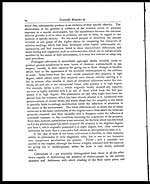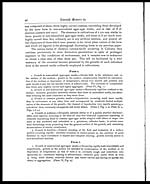Medicine - Institutions > Army health reports and medical documents > Scientific memoirs by medical officers of the Army of India > Part VIII, 1894 > 1 - Results of continued study of various forms of comma-bacilli occuring in Calcutta
(31) Page 25
Download files
Individual page:
Thumbnail gallery: Grid view | List view

Medical Officers of the Army of India.
25
by the fact that a perfect pellicle never forms on its surface. A dense, white ring
of pellicle does eventually tend to appear around the edge of the fluid in contact
with the wall of the tube, but it never attains any breadth because it is so brittle
and of such high specific gravity that the slightest agitation serves to detach
flocculi from the inner edge of the ring which immediately sink to the bottom
of the tube. A conspicuous accumulation of deposit thus gradually arises,
which usually rises to the surface in the form of one or two large flocculent
masses on the addition of acids. In the case of form λ also there is great delay
in the formation of a pellicle, and the distinctive peculiarity lies in the very
rapid and dense clouding of the fluid which at the same time acquires a peculiar
light, whitish tint, quite unlike that present in the cultivations of any other
form. The phenomena attending the development of purple on the addition of
acids are also peculiar, for not only is the degree of colouration invariably rela-
tively limited, but its distribution is peculiar, the central portion in the depth of
the column of fluid retaining its original pale tint almost unaltered, whilst a
stratum of purple makes its appearance both at the bottom and surface. The
cultivations of form δ closely resemble those of ι , save in their failure to show any
trace of purple on the addition of acids. The above three forms constitute a
group the members of which are distinguished from all the other choleraic
comma-bacilli with which I am acquainted by the fact that their cultivations in
bouillon present features of diagnostic value. In the case of cultivations of the
other forms certain minor differences are frequently recognisable, but these are
neither of sufficient magnitude nor constancy to serve per se as safe grounds for
diagnosis. For example, cultivations of form α are certainly characterised by
the rapidity with which the fluid clears after the addition of acids, and in many
series of comparative cultivations this would serve to distinguish them from
those of any other form, but in certain instances, doubtless in connection with
minor peculiarities in the constitution of the medium, one or more of the other
forms yield similar results, so that whilst the constancy of rapid and complete
clearing is certainly characteristic of α, it isnot a character of certain diagnostic
value in all cases.
Very few forms are capable of growing at all in non-neutralised bouillon, and
only two are capable of free and relatively rapid growth. These are forms δ and
λ . In the case of the former clouding of the fluid occurs slowly, but a pellicle
ultimatelyis formed; in that of the latter dense clouding takes place rapidly,
but a pellicle is absent. In spite of the rapidity with which clouding occurs in
cultivations of λ, and the general similarity of the phenomena to those occurring
in neutralised bouillon, there is an entire absence of any trace of purple colouring
on the addition of acids. The only other forms which have hitherto yielded any
appreciable growth in non-neutralised bouillon are γ and θ, in both cases the
development was very slow and confined solely to the surface of the fluid, which
ultimately became clothed by a thin and imperfect pellicle, which in the case of γ
E
Set display mode to: Large image | Zoom image | Transcription
Images and transcriptions on this page, including medium image downloads, may be used under the Creative Commons Attribution 4.0 International Licence unless otherwise stated. ![]()
| Permanent URL | https://digital.nls.uk/75002095 |
|---|
| Shelfmark | IP/QB.10 |
|---|---|
| Additional NLS resources: | |




